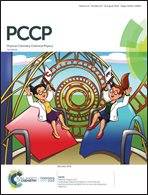Assessing a thermal spike model of swift heavy ion–matter interactions via Pd1−xNix/Si interface mixing†
Abstract
The thermal spike model (TSM), a widely accepted mechanism of swift heavy ion (SHI)–matter interactions, provides explanation for various SHI induced effects, including mixing across interfaces. We assess the validity of the model via tuning the electron–phonon coupling strength (G) by taking a series Pd1−xNix of a completely solid soluble binary, and then observing Pd1−xNix/Si interface mixing induced by a combination of 100 MeV Au ion irradiation and 4 keV Ar ion sputtering. If the TSM truly describes the SHI–matter interaction mechanism, any non-linearity in x-variation of G must also result in a similar non-linearity in the x-dependence of mixing. Experimentally, the extent of mixing has been parametrized by the irradiation induced change Δσ2 in variances of Pd and Ni depth profiles derived from XPS. Computationally, G determined using density functional theory has been used to solve the equations appropriate to the TSM, and then an equivalent quantity L2, proportional to Δσ2, has been calculated. Both Δσ2(x) and L2(x) show non-linearities, albeit in slightly dissimilar ways, leading to a conjecture that the present work at least does not invalidate the TSM.



 Please wait while we load your content...
Please wait while we load your content...